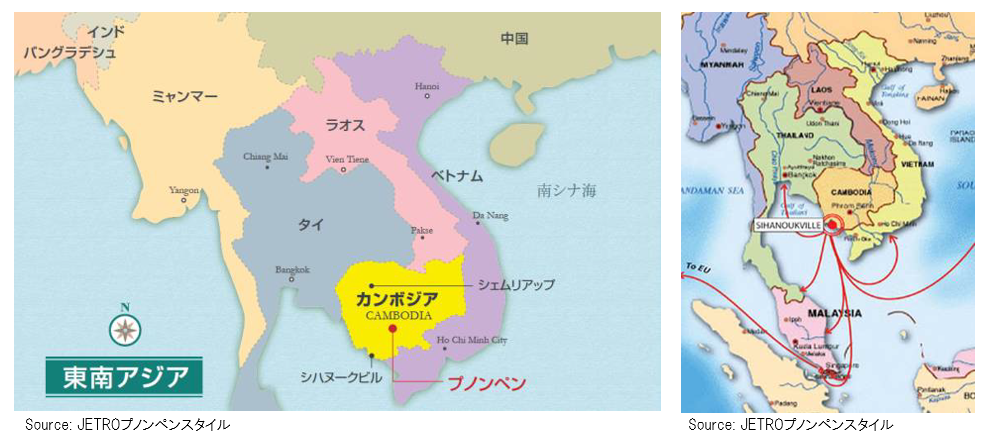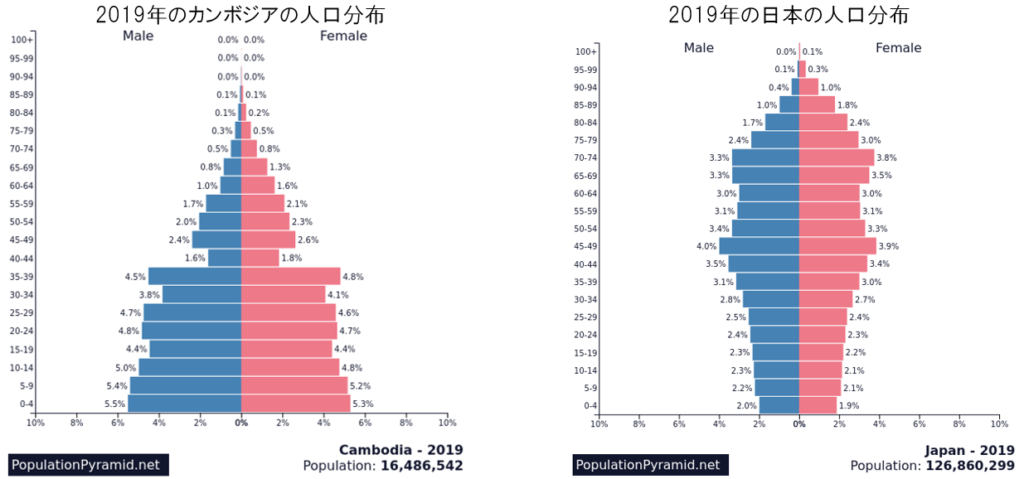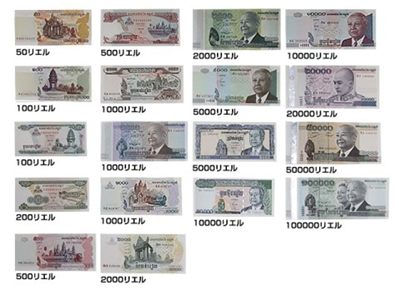カンボジアはASEANの中央に位置します
カンボジアの正式名称は「カンボジア王国」、東南アジアのインドシナ半島にある国です。世界遺産アンコール・ワットで有名です。タイとベトナムに挟まれ、ラオスと国境を接するASEAN10か国の中央に位置します。
カンボジアの首都プノンペンは、タイの首都バンコクとベトナムの最大都市ホーチミンのちょうど中央に位置し、これらの都市は陸路で繋がっています。メコン川を擁し、南シナ海にも面するといったとても立地の良い国です。
面積は日本の約半分(181,035 km2)程で、日本との時差は2時間です。地震もなく自然災害のリスクが少ない国です。カンボジアは1953年にフランスから完全独立しました。過去の混乱期を乗り越え、現在は立憲君主制による政治で安定しています。

カンボジアはクメール語
カンボジアの公用語・母国語は「クメール語(Khmer)」です。文字は「クメール文字」を使い、文法は英語と同じです。カンボジア語とも呼ばれますが、正式にはクメール語で、カンボジア人もクメール人が正しい呼び方です。カンボジアの人々はほとんどが仏教徒です。フレンドリーで礼儀正しく、家族想いです。
現地の方同士はクメール語で会話をしますが、カンボジアは大抵どこへ行っても英語が通じます。空港やホテル、銀行、観光地やタクシー、トゥクトゥク、レストランなども英語でコミュニケーションがとれ、GDPがカンボジアよりも高い隣国のベトナムやタイと比べてもはるかに英語が通じます。看板やメニューなどもクメール語に併せて英語でも表記されています。
カンボジアは若者が溢れる国
カンボジアの人口は約1,650万人で、国民の約半数が30歳以下というとても若者の多い国です。 きれいなピラミッド型の人口分布は、60%以上が労働人口、少年者が30%、高齢者はなんと9%以下です。日本は平均年齢45歳、65歳以上比率が28.4%となっています。カンボジアの人口増加率は年1.4%、人口爆発は始まったばかりで少なくとも2045年まで続くといわれています。

カンボジアは米ドルが使えます
カンボジアでは自国通貨リエル(KHR)と米ドル(USD)が両立しています。約4000リエル=1米ドルと計算されます。今では流通額の約90%が米ドル、預金口座の米ドル率も90%以上となっています。トゥクトゥクの乗車時や屋台で買い物をする時など少額の場合であっても米ドルを使用することができ、キャッシュレス化も進んでいます。
日本円からの両替は米ドルに換金するのが一般的です。街の両替所と銀行がレートが良く、リエルを大量に渡されるということはまずありません。インターネットや電話で申し込める外貨宅配というサービスもあります。普段の生活では、米ドルの補助通貨(コインの代わり)としてリエルが使われる場面が非常に多くあります。1USD以下のお釣りはリエル紙幣で受け取ることになりますので是非リエル紙幣にも慣れておきましょう。
リエル(KHR)は公式に発行されている紙幣は20種類以上存在しますが、実際に流通しているのは18種類のみです。500リエルには日本の国旗が印刷されています。
50, 100(2種), 200, 500(2種), 1000(3種), 2000(2種), 5000(2種), 1万(2種), 2万, 5万, 10万 KHR
リエルの硬貨も4種類ありますが実際には流通していません。硬貨については米ドルのセント硬貨も流通していませんので、リエルも米ドルも紙幣のみです。カンボジアでは小銭用のお財布は不要になります。

カンボジアはアジア屈指の高成長
カンボジアはGDP成長率が毎年7%台と高値で推移し、労働力・購買力・消費のそれぞれが堅調に増加しています。これはアジアでも屈指の高成長ぶりです。日本は0.3%(2018)となっています。急速な経済成長と安定した政治情勢を反映して多くの外国企業がカンボジア市場に進出してきています。
外国からの投資を広く受け入れるカンボジアは、外国から見ても為替リスクが少なく、今後のポテンシャルを持っていることが投資先として魅力的であり、それら経済成長促進要因になっていると言えます。

カンボジアの通信事情
カンボジアではオンラインビジネス、アプリサービス、キャッシュレス支払などが至る所で行われています。ローカル向けレストランから国会議事堂建物内までフリーWi-Fiが利用でき、プノンペンをはじめ地方都市部においても環境が整っています。カンボジアは1993年に世界で初めて携帯電話加入者が固定電話加入者を上回った国となっています。(国際電気通信連合統計)地方部では電気が引かれていなくても、携帯電話に関しては仕事や家族との連絡で使うため8割以上の方が持っています。普及率は、携帯電話が 118%(2018 年)、固定電話が 0.84%(2017 年)、インターネットが 75%(2018 年)となっています。

携帯電話は日本では月額料金後払いが一般的ですが、カンボジアではプリペイド式の先払いが主流です。数ドルでSIMカードを購入すれば、1GBのデータ通信が3ドル程で必要な分をチャージできます。使い切った時点で通信が出来なくなるわかり易いシステムなので、現地にお越しの際は購入をオススメします。
パソコンやスマートフォンの充電も問題ありません。カンボジアのコンセントの形状は、AタイプとCタイプが一般的で、ほとんどが両方が差し込める兼用タイプです。日本の電源プラグはAタイプなので変換機なしでそのまま差し込むことができます。電圧については、カンボジアは220Vで日本の100Vよりも高いため、日本の電気製品を使用する場合は変圧器が必要です。パソコンやスマートフォンの充電器のように「INPUT:100~240V」と表記のある電化製品はカンボジアでも変圧器なしで使用できます。
カンボジアの医療
駐在日本人数との比率で考えると、カンボジアは他の国と比較して日本人医師が多いのが特徴です。カンボジア(プノンペン)では、日本人医師や日本人看護師が常駐している医療機関が複数あり海外旅行保険も適用されます。複数の日本人専門医、入院サービス、日本製の医薬品、日系の眼科や歯科もあり、予防接種や緊急時対応を行っている病院もあります。受付から診療まで日本語で対応できるので、日本人医師のいる病院が少ないという不安要素はカンボジアでは比較的低いと考えられます。
カンボジアの交通事情
カンボジアではタクシーよりも、トゥクトゥク、PassAppやGrabといった配車アプリを使用するのが主流です。現地ではバイクも多く走ります。レンタルバイク屋さんもあり、カンボジアでは外国人でも125CC以下のバイクであれば免許は不要です。車や大型バイクは「国際運転免許証」で運転することが可能ですし、長期滞在時はカンボジアで免許の書き換えをすることも可能です。カンボジアでは車の免許でバイクを運転することはできませんので必要に応じて2種類の免許を取得します。
カンボジアのホテル
カンボジアにはバックパッカーに人気のゲストハウスから5つ星高級ホテルまで様々なホテルがあります。ゲストハウスは1泊5〜15ドル程で日系企業が経営するものもあります。中級ホテルは20〜70ドル程で、和朝食を提供するビジネスホテルもあり様々です。経済発展を続けるカンボジアにはもちろん高級5つ星ホテルもあり、1泊100〜300ドルほどとなっています。世界的に有名なハイアットホテル、マリオットグループのコートヤードホテルなども進出しており、シャングリラホテルは現在建設中です。
カンボジアの居住費
中長期滞在する場合には、コンドミニアムやアパートメントを賃貸する選択肢もあります。カンボジアの家賃は一等地は高いですが、郊外に行くとかなり安くなります。1ベットルームであれば郊外でエアコンやシャワーつきの物件の場合、家賃は最も安くて月200ドルほど。一方、立地が良く家具家電がある程度揃っているコンドミニアムや、ジム・プールつきのサービスアパートメントであれば月500ドル〜1000ドル程度が相場です。2ベットルームで月2000ドル程度、3ベットルームになると月3000ドル程度となります。
カンボジアの光熱費
カンボジアの電気料金は1㎾当たり約1500リエル(約40円)です。日本の電気料金は1㎾あたり30円前後が相場なので、電気代は日本より高いです。経済成長とともに電力自給率は上昇していますが、未だ近隣諸国から電気を輸入していることが理由です。
ガス料金は初期費用で約60ドルかかりますが、それ以降は詰替え用のみで15Kg当たり15~20ドルほどです。一度詰替えると3か月程持つので、日本よりも安い印象です。
水道料金は1㎥当たり1500~2000リエル(約40~54円)です。日本の水道料金は1㎥当たり平均160円ほどなので、日本と比較するとカンボジアの水道料金はとても安いです。1人暮らしの1か月の平均水使用量が8㎥とすると、月の水道料金は約1万4000リエル(約375円)です。賃貸では水道代は家賃に含まれる物件も多くあります。
飲み水についてはカンボジアの家庭ではウォーターサーバーを設置するのが一般的になってきました。サーバーを100ドルほどで購入し5リットルのボトルをセットします。ボトルは1本1ドル程度で購入できます。しかしカンボジアの首都プノンペンに限っては日本のJICAの支援で水道整備事業が成功し、水道の蛇口から汲んだ水をそのまま飲むことができる程の水質です。事業が始まったのは90年代ですが、いまだに水道の質は高いまま保たれています。日本の方にとっては当たり前ですが、東南アジアを訪れたことがある方ならこれがいかに画期的なことかお分かりいただけるでしょう。